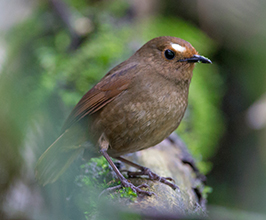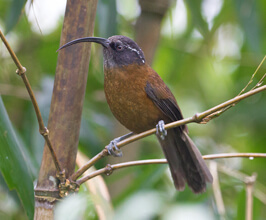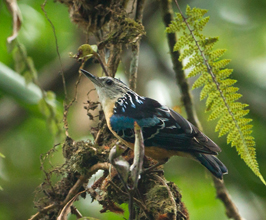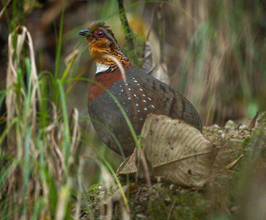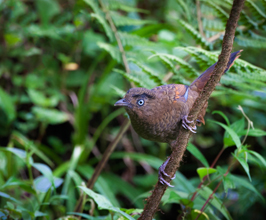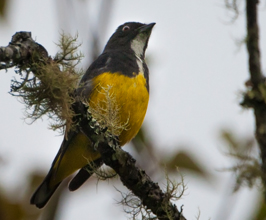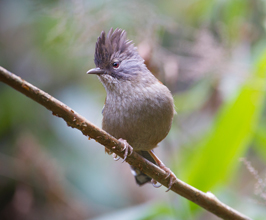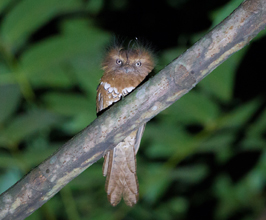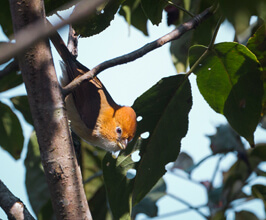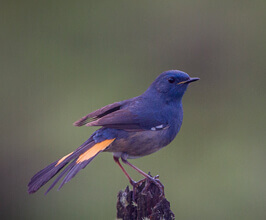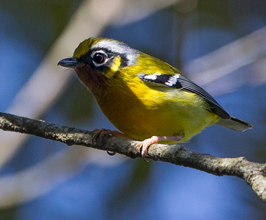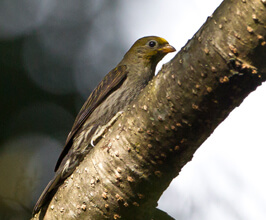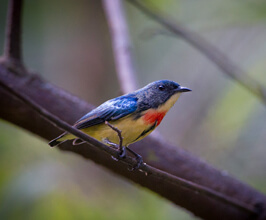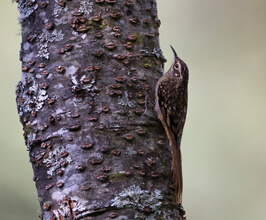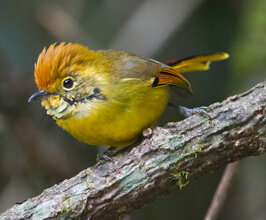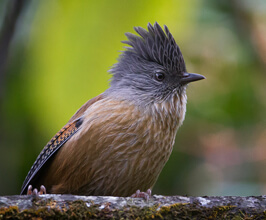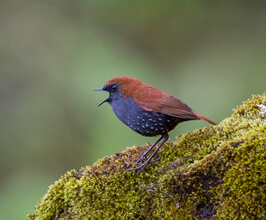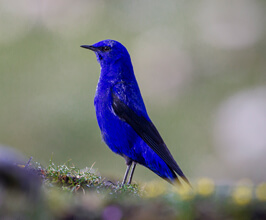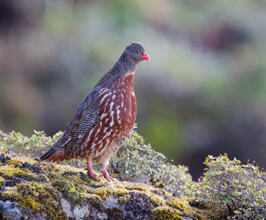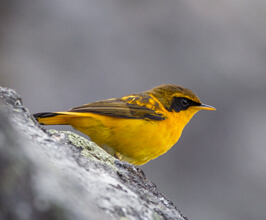Guwahati – Nameri National Park - Lama Camp – Bompu Camp - Sessni Camp - Khellong - Eaglenest Pass - Dirang – Sangti Valley - Sela Pass - Mandala Top - Guwahati
13 Days / 12 Nights
Are you an ornithophile and someone who loves adventures? Then, you are at the right place!
Booked as per
Commitment.
Included except arrival and departure city.

Private guide for complete tour.
Airport to Airport.
2-8PAX
Included
Are you an ornithophile and someone who loves adventures? Then, you are at the right place!
The key attraction of our birding adventures in Northeast India is Eaglenest. Its uniqueness as a location for bird-watching rests in its isolation, altitudinal variety, enormous biodiversity, and numerous rare and exotic bird species.
Sounds fabulous, right?
The 217 sq. km Eaglenest Wildlife Sanctuary, located in the foothills of the Himalayas of Arunachal Pradesh, is truly a gift from nature to birdwatchers and is known as the "Jewel of Indian Birding."
It is exceptional to uncover a hotspot for bird watching with altitudes ranging from 500 to 3250 meters, with hundreds of bird species surviving in the dense forest canopy. Tropical evergreen forests cover the lower elevations, giving place to temperate deciduous and conifer forests at the middle elevation and alpine forests at a higher elevation.
Your Eaglenest Birding Tour spans the entire range and ascends even farther to an elevation of up to 4000 meters at the Sela mountain pass in search of the birds that are highly uncommon to see in one's lifetime.
Also, do you know that Eaglenest has been elevated to the world's top birding attractions list? Great, right? And this is only possible because of Bugun Liocichla, a relatively recent discovery which is one of the most desired feathery treasures.
Undoubtedly, Eaglenest is an ecological hotspot. The entire Eaglenest range is extremely rich in mammals, including the Red Panda, Clouded Leopard, Asiatic Elephant, Tigers and Leopard variety of Squirrels, Wild Bison, Dhole, Arunachal Macaque, and Capped Langur. In addition to excellent birding, the area is also home to the Golden Cat, Marble Cat, Leopard Cat, and other species.
Wait, it doesn't end here. Researchers and lovers of butterflies, moths, frogs, and reptiles should also value Eaglenest.
Our two-week schedule for the Eaglenest bird-watching getaway includes full or partial birding days each day. At the beginning of the long vacation, a quick Birding Tours of Delhi, India's capital, gets you ready.
The birding adventure then travels hundreds of kilometres to north eastern India, which is home to several reserves, national parks, and sanctuaries.
Excited? Read on to learn more about this adventure.
Our first break on our Himalayan birding journey is at Nameri National Park, located on the border of Assam and Arunachal Pradesh. Can you believe there are over 375 bird species in the park, including the White-winged duck, which is Assam's national bird?
As we go north, we enter the Eaglenest Wildlife Sanctuary at Lama Camp and continue climbing to the 1950-meter-high Bompu Camp. We will base ourselves at this camp, which offers a tented stay, for many days of birding at Eaglenest. From here, we travel further to Khellong hamlet and explore the mid-altitude woods at Sessni camp.
So let's roll into the Eaglenest Birding Tour itinerary.
Our targets for the eaglenest birding tour include Chestnut-breasted Partridge, Beautiful Nuthatch, Blyth's Kingfisher, Eyebrowed Wren Babbler, White-hooded Babbler, several species of Shortwings, Rufous-vented Laughingthrush, Red-faced Liocichla, Himalayan Cutia, Brown Parrotbill, Red-billed Scimitar Babbler, Coral-billed Scimitar Babbler, Blue-winged Laughingthrush, Rufous-throated Wren Babbler, Crested Goshawk, Besra, Eurasian Sparrowhawk, Northern Goshawk, Black Eagle, Rufous-bellied Eagle, Mountain Hawk Eagle, Blue-naped Pitta, Silver-breasted Broadbill, Maroon-backed Accentor, Hill Partridge, Rufous-throated Partridge, Chestnut-breasted Partridge, Blyth's Tragopan, Temminck's Tragopan, Eurasian Woodcock, Wood Snipe, Jerdon's Baza, Long-tailed Broadbill, Golden-fronted Leafbird, Orange-bellied Leafbird, Collared Treepie, Spotted Nutcracker, Slender-billed Oriole, Maroon Oriole, Black-winged Cuckooshrike, Grey-chinned Minivet, Sikkim Wedge-billed Babbler, Rufous-throated Hornbill, Grey Peacock Pheasant, apart from many others.
The checklist of Eaglenest birds is quite long, and to mark off several exotic and rare species we head westward to the town of Dirang. Keeping it as our base, we explore the high-altitude birding trails at Sela Pass (4160m) and Mandala Top (3000m), looking for avian specialties such as Snow Partridge, Himalayan Monal, Blood Pheasant, Grandala, Rare Gould's Shortwing, Solitary Snipe, Upland Buzzard, White-browed Rosefinch, Plain Mountain Finches, Eurasian Sparrowhawk, Red-billed Chough, Snow Pigeon, Alpine Accentors, Little Owl, Red-fronted Rosefinch, White-browed Tit-warbler, Himalayan Buzzard, Blanford's Rose Finch, Brown bush Warbler, Gould's Shortwing, Naumann's Thrush, Red-throated Thrush, Black-throated/Plain-backed Thrush, White-bellied Redstart, Beautiful Sibias, Fire-capped Tit, Blue-fronted Robin, Spotted Nutcracker, Blue-capped Rock Thrush, and Ward's Trogon.
Over a period of 14 days, we cover the best birding trails of Eaglenest while scouring the forests, the mountain passes of Eaglenest and Sela, the Sangti Valley, Sessa Orchid Sanctuary, and even the lowland woods of Assam. On several occasions, we camp out in tents or birding lodges, we drive past scenic locations with stunning views of the majestic Himalayas, and we even have encounters with wildlife to turn our Eaglenest birding expedition into a sort of Himalayan adventure holiday.
Lodging: The number of lodging alternatives decreases with increasing distance from the birding area. You get to spend many days in tents with cots and comfortable bedding because most of our Eaglenest Bird-watching Tour takes place in remote birding locations. Both Lama Camp and Bompu Camp share a bathroom. During our journey, only Delhi and Dirang have luxury accommodations available. You can spend three nights at a Mandala birding lodge. Other than that, the hotels and tents will only enhance your birding excursion in Northeast India.
Meals: Meals vary depending on the lodging. Our skilled culinary team prepares delectable vegetarian and meat-based meals for us on the nights we spend in camps and lodges. Since there aren't many culinary items in these remote locations, we rely on our stock, which offers enough variety to keep your stomach full for a few days. We look after the hygiene factor as our culinary crew always uses sanitary cooking techniques. While we are visiting Delhi, Nameri, and Dirang, you can get more dining alternatives accessible.
Tour Difficulty: All the birding locations on our Eaglenest birdwatching trip are accessible by motorable road. We traverse mountainous terrain and do bird walks at altitudes as high as 4160 meters and spend nights in a lodge at 3000 meters. You should be physically fit and strong to be able to withstand high-altitude conditions. The birding trails may require uphill or downhill slog, or simply long hours of walking with your birding equipment, such as binoculars, camera, field guide and backpack. Given the rigours, we accept only birders aged between 15 and 65 for this tour.
Tour Extension: Northeast India holds out several other tourist attractions. The region has many Buddhist monasteries with their ancient relics, colourful paintings, sculptures, quaint architecture, religious rituals and customs. You may want a cultural trip to these intriguing temples of worship. Or you may want a wildlife safari in Kaziranga National Park or a leisure trip to the rock music capital of India, Shillong, in Meghalaya. Whatever the tour extension you wish for, just let us know well in advance so that we can make necessary arrangements to extend the Eaglenest birding expedition as per your liking.
Climate: The best time to do our Eaglenest birdwatching tour is from October to mid-May. This is winter and spring season in the region, and the weather is cold at high elevations of Sela Pass, Mandala Top, Eaglenest Pass and even Bompu Camp. For these locations, you must carry enough winterwear. The weather is somewhat warmer and pleasant at lower heights and summer clothes are suited for the spring season. Do carry a quality raincoat as well for odd shower or two.
You arrive in the heart of Northeast India Guwahati, Our tour guide and driver picks you up from the airport, they immediately take you on a short birding tour of outskirts of Guwahati. Guwahati is a busy metropolis, yet there are a few spots on the outskirts where one may still witness a fascinating diversity of birds. Greater Adjutant Stork is the object of our brief excursion. After our bird-watching excursion, we will hop in a car and head to Nameri National Park, a 5-hour drive away. We stop for lunch at a wayside eatery and reach our location by nightfall, leaving us with a few extra hours to go bird-watching in the area.
Nameri National Park is accessed by ferrying across the river Jia-Bhoroli, which flows along the southern boundary of the park. Crossing the river, one enters a biodiversity hotspot of semi-evergreen deciduous forests, bamboo brakes, and sporadic grasslands, which are home to a variety of flora and fauna, including 375 species of birds.
Quite early in the morning, we take a boat to cross the river and enter the park. We do birding walks on a selected stretch of the park and look for the likes of White-winged Duck (state bird of Assam), Blyth’s Kingfisher, Great Thick-knee, Wreathed Hornbill, Red-breasted Parakeet, White-capped River-chat, Long-billed Plover, Blue-naped Pitta, Wreathed hornbill, White-cheeked Partridge, Lineated and Blue-throated Barbets, Pin-tailed, Ashy-headed Green and Green Imperial Pigeons, Pied Flycatcher-Shrike, Yellow-browed, Greenish and Grey-hooded Warblers, Oriental Hobby, Pied Falconet, Pallas’s Fish-Eagle, Black Baza, Peregrine Falcon and Ibisbill.
After a successful morning spent birding in Nameri National Park, we head back to our hotel for breakfast before making the approximately four-hour trip to Lama Camp. We halt at the Sessa Orchid Sanctuary along the route for a brief birding tour. In the evening, we will reach Lama Camp. There you have your dinner and stay for the night.
You can enter the Eaglenest Wildlife Sanctuary through Lama Camp. There is a lot to discover as the sanctuary spans 218 square kilometres. After having a cup of coffee, we immediately started surveying the woodland area around Lama Camp. The rare and seriously endangered Bugun Liocichla, a little babbler whose discovery in 1995 and re-sighting in 2006, gained Eaglenest Wildlife Sanctuary much recognition as a birding destination. This will be our primary aim for the day.
We set off right after the morning coffee to scan the forest around Lama Camp. Our main target for the day is the rare and critically endangered Bugun Liocichla, a small babbler whose discovery in 1995 and re-sighting in 2006 brought much fame to Eaglenest Wildlife Sanctuary as a birding destination. Apart from this little beauty, our targets for morning birding at Lama Camp include Himalayan Cutia, Brown Parrotbill, Red-billed Scimitar Babbler, Coral-billed Scimitar Babbler, Blue-winged Laughingthrush, Rufous-throated Wren Babbler, Maroon-backed Accentor, Hill Partridge, Rufous-throated Partridge, Chestnut-breasted Partridge, Blyth's Tragopan, Temminck's Tragopan, Yellow-rumped Honeyguide, Rufous Woodpecker, Pale-headed Woodpecker, Bay Woodpecker, Rufous-bellied Woodpecker, Crimson-breasted Woodpecker, Darjeeling Woodpecker, Golden-throated Barbet, Blue-throated Barbet, Blue-eared Barbet, Coppersmith Barbet, Great Hornbill, Ward's Trogon, Hodgson's Frogmouth, Barred Cuckoo Dove, Thick-billed Green Pigeon, and Mountain Imperial Pigeon.
So much birding comes out of the early morning hours at Lama Camp. After breakfast, we hit the road to Bompu Camp for a 32-km ride that goes through the Eaglenest Pass and several birding trails we stop by to explore. These excursions on the drive to Bompu Camp yield the likes of Eurasian Woodcock, Wood Snipe, Jerdon's Baza, Crested Goshawk, Besra, Eurasian Sparrowhawk, Northern Goshawk, Black Eagle, Rufous-bellied Eagle, Mountain Hawk Eagle, Blue-naped Pitta, Silver-breasted Broadbill, Long-tailed Broadbill, Golden-fronted Leafbird, Orange-bellied Leafbird, Collared Treepie, Spotted Nutcracker, Slender-billed Oriole, Maroon Oriole, Black-winged Cuckooshrike, Grey-chinned Minivet, Blue-capped Rock Thrush, Chestnut-bellied Rock Thrush, Plain-backed Thrush, Long-tailed Thrush, White-collared Blackbird, Chestnut Thrush, Yellow-bellied Flowerpecker, Bar-winged Wren Babbler, Beautiful Sibia, White-tailed Robin, Blue-fronted Robin and species of Parrotbills.
After a busy day of birding, we overnight at Bompu Camp.
Bompu Camp's position makes it a popular destination for birdwatchers. It is surrounded by vast fields on one side and thick woodland on the other at the height of 1950 meters. Various tented accommodations may be found along the muddy road through Bompu; they will serve as our home for the next three nights. After breakfast, we will start our tour of Eaglenest Wildlife Sanctuary's middle woodland. We have to take a car down to Sessni Camp, where the road slopes downward and offers excellent opportunities for bird-watching.
After breakfast, we set out to explore the middle-forest range of Eaglenest Wildlife Sanctuary. We drive down to a place called Sessni Camp. The road goes downhill and presents great birding opportunities. On our birding excursions here, we look out for Sikkim Wedge-billed Babbler, Rufous-throated Hornbill, Grey Peacock Pheasant, Chestnut-breasted Partridge, Beautiful Nuthatch, Blue-naped Pitta, Long-tailed Broadbill, Golden-fronted Leafbird, Orange-bellied Leafbird, Lesser Shortwing, White-browed Shortwing, Dark-sided Flycatcher, Ferruginous Flycatcher, Purple Cochoa, Green Cochoa, Fire-capped Tit, Rufous-vented Tit, Coal Tit, Yellow-cheeked Tit, Striated Bulbul, Mountain Bulbul, Hill Prinia, Chestnut-headed Tesia, Slaty-bellied Tesia, Grey-bellied Tesia and several others.
After a fruitful day of birding around Sessni, we return to Bompu camp in the evening for dinner and overnight.
We will cover the bird-watching routes at various elevations because Eaglenest Wildlife Sanctuary is dispersed over several heights, ranging from 500 to 3250 meters. We move on lower to the sanctuary's low-range woodland today after searching the mid-altitude Sessni camp the day before. After breakfast, we go to the Arunachal Pradesh hamlet of Khellong in the West Kameng district. Khellong is a tiny community with a few hundred residents maxima. This characteristic and the village's isolation have made Khellong and the surrounding surroundings good locations for birding in Eaglenest Wildlife Sanctuary's lower altitude.
On our full day birding expedition to Khellong, we aim to see the likes of Silver-bellied Broadbill, Blyth's Kingfisher, Eyebrowed Wren Babbler, White-hooded Babbler, several species of Shortwings, Rufous-vented Laughingthrush, Red-faced Liocichla, Abbott's Babbler, Buff-breasted Babbler, Spot-throated Babbler, Large and Hill Blue Flycatcher, Pale-headed Woodpecker, Slender-billed Scimitar, Red-headed Trogon, Rufous-backed Sibia, Long-tailed Sibia and a lot more. On the way back to Bompu Camp in the evening, we seek out Hodgson's Frogmouth. Dinner and overnight at Bompu Camp.
We are already on day 7!
Birdwatchers sometimes ask us for extended periods of birding in these lower locations since the birding paths there are so rich in avian specialities compared to those at Bompu Camp. Due to this, we have permanently added a second birding trip to Sessni and Khellong to our schedule for the Eaglenest birding expedition in Arunachal Pradesh.
As we descend to Khellong's much lower height, we observe a shift in the bird species. The chances of spotting Speckled Piculet, Red-faced Liocichla, and Red-headed Trogon are higher here. As dusk falls, we begin to make our way back to Bompu Camp's elevation, but we don't stop birding along the way. Lastly, Bompu Camp hosts delicious dinners; you are free for the night.
Our following birding goals are elevations higher than Bompu Camp now that we are finished with the lower-level woodlands. Recognizing various bird species that live at multiple elevations is undoubtedly an advantage of birding at Eaglenest Wildlife Sanctuary.
After breakfast, we drive to the birding trails located upwards of Bompu Camp. Birdwatching here reveals the likes of Blyth’s Tragopan, Temminck's Tragopan, Ward's Trogon, Fire-tailed Myzornis, Chestnut-headed Tesia, Slaty-bellied Tesia, Grey-bellied Tesia, Eurasian Woodcock, Wood Snipe, Orange-flanked Bush Robin, Golden Bush Robin, White-browed Bush Robin, Rufous-breasted Bush Robin, Grey-sided Laughingthrush, Bhutan Laughingthrush, Blue-winged Laughingthrush, Scaly Laughingthrush, White-browed Scimitar Babbler, Streak-breasted Scimitar Babbler, Coral-billed Scimitar Babbler, Slender-billed Scimitar Babbler, Rufous-fronted Babbler, Rufous-capped Babbler, Golden Babbler, Grey-throated Babbler, Striped Tit Babbler, Silver-eared Mesia, Red-billed Leiothrix, Cutia, Black-headed Shrike Babbler, White-browed Shrike Babbler, Green Shrike Babbler, and Black-eared Shrike Babbler.
High-altitude birding is quite active today at Eaglenest Wildlife Sanctuary. In the evening, we drive back to Bompu Camp for dinner and overnight.
After breakfast, we get ready and head for Lama Camp, crossing the 2800-meter Eaglenest Pass again on the route. We stop travelling at the pass to search the surrounding regions for the birds on our list that still need to be ticked off.
Our targets for birding at Eaglenest Pass include Brown Parrotbill, Grey-headed Parrotbill, Fulvous Parrotbill, Mrs Gould's Sunbird, Green-tailed Sunbird, Fire-tailed Sunbird, Tibetan Siskin, Dark-breasted Rosefinch, Dark-rumped Rosefinch, Crimson-browed Finch, Rusty-fronted Barwing, Streak-throated Barwing, Golden-breasted Fulvetta, Yellow-throated Fulvetta, Rufous-winged Fulvetta, Brown-throated Fulvetta, Nepal Fulvetta, Chestnut-tailed Minla, Fire-tailed Myzornis, Scarlet Finch, Brown Bullfinch, Red-headed Bullfinch, Grey-headed Bullfinch and many more avian wonders.
We continue heading towards Lama Camp as dusk falls. If there is time, we could pause along the route to visit other birding paths. There is a Tragopanda Trail not far from Lama Camp, and there is a fair possibility we will encounter Temminck's Tragopan and Red Panda there. After dinner, stay the night at Lama Camp.
An early breakfast is followed by a birding excursion near Lama Camp to start the day. We search the area for the birds on our checklist that are missing. After our little birding tour, we packed up and went west to the Arunachal Pradesh town of Dirang.
The trip takes between four and five hours and goes through Bomdilla, a popular tourist destination because of the Bomdila Pass, which offers spectacular views of the Gorichen and Kangto peaks. We stop for lunch at Bomdila before continuing on to Dirang.
When we get to Dirang, you settle into the hotel reserved in advance so that we may leave on a short birding tour in the nearby Sangti Valley. Sangti Valley is a charming valley encircled by breathtaking Himalayan mountains. It has been a favourite hangout for many birders in recent years due to the enormous diversity of species that call it home. The Ibisbill, Long-billed Plover, wintering Wallcreepers, Black-necked Cranes, and Black-tailed Crakes are just a few of the beautiful birds we look for here
We return to our hotel in Dirang in the evening for supper and to stay the night. We go to bed on time so that we can wake up early the next day.
We leave at around 3 am and head north to Sela Pass, which is aptly known as the entrance to the town of Tawang due to its elevation of 4160 meters. We carry our breakfast, which we consume on the route. The purpose of leaving so early is to arrive at Sela Pass around sunrise. About 9 kilometres before the pass itself, birding at Sela Pass begins. We start our birding trek in the early morning to search for Arunachal Pradesh's high-altitude birds.
About 9 kilometres before the pass itself, birding at Sela Pass begins. We start our birding trek in the early morning to search for Arunachal Pradesh's high-altitude birds of Arunachal Pradesh such as Snow Partridge, Himalayan Monal, Blood Pheasant, Grandala, Rare Gould's Shortwing, Solitary Snipe, Upland Buzzard, White-browed Rosefinch, Plain Mountain Finches, Eurasian Sparrowhawk, Red-billed Chough, Snow Pigeon, Alpine Accentors, Little Owl, Red-fronted Rosefinch, White-browed Tit-warbler, Himalayan Buzzard, Yellow-breasted Greenfinch, Dark-breasted Rosefinch, Himalayan Beautiful, Dark-rumped Rosefinch and several others. Sela Pass also offers stunning views of the eastern Himalayan peaks.
We go back to Dirang in the evening and then head farther south to Mandala. We will book a room at a birding lodge in Mandala. Lastly, you will have your dinner and rest at the inn.
About 30 kilometres separate Dirang from Mandala Top. Since the 108 little Buddhist temples that have just lately been built together, it is becoming a popular tourist destination. Additionally, Mandala Top's elevation of 3000 meters provides a vantage point from which you can watch the impressive Himalayan mountain range.
Mandala Top is a fantastic location to look for high-altitude species from a birding viewpoint. At Mandala Top, we go bird-watching twice on consecutive days. You can view fascinating species at Mandala Top are Blanford's Rose Finch, Brown bush Warbler, Temminck's Tragopan, Gould's Shortwing, Naumann's Thrush, Golden-breasted Fulvettas, Bar-tailed Treecreeper, Rufous-chinned and Grey-sided Laughingthrushes, Scaly-breasted Cupwing, Grey-sided Bush-warbler, Fulvous and Black-throated Parrotbills, Black-throated, White-collared and Grey-winged Blackbirds, Himalayan Bluetails, Eurasian Nutcracker, Speckled Wood-pigeon, Wood Snipe, Red Crossbill, Gould’s Shortwing, Scarlet Finch, Brown Bullfinch, Red-throated Thrush, Black-throated/Plain-backed Thrush, White-bellied Redstart, Beautiful Sibias, Fire-capped Tit, Blue-fronted Robin, Spotted Nutcracker, Blue-capped Rock Thrush, Ward's Trogon, Slender-billed Scimitar-Babbler, Spotted Laughingthrush, Crimson-browed Finch, Large-billed Leaf-Warbler, Ludlow's Fulvetta, Rusty-flanked Treecreeper, Fire-tailed Myzornis, White-throated & Grey-sided Laughingthrushes, Red-tailed Minla, Yellow-browed, Black-browed and Rufous-vented Tits, Green-tailed Sunbird, Chestnut-tailed Minla, Black-faced Warbler, Stripe-throated Yuhina, Red-headed Bullfinch, Grey-headed Bullfinch, Collared Grosbeak, Spot-winged Grosbeak, Gold-naped Finch, and Little Bunting.
At Mandala Top one may also see interesting wildlife such as Red Panda, Himalayan Serow, Arunachal Macaque and Flying Squirrels. We overnight at Mandala birding lodge on both days.
Here we come to the end of our Eaglenest bird-watching adventure.
After breakfast, we leave for the lengthy drive from Mandala Top to Guwahati, Assam. The nine-hour journey passes through the Phudung and Shergaon woods. We stop for a short while along the trip to conduct some birding. We concentrate on the bamboo patches and lower portions of the forest.
Then we will transfer you off to the airport for your next flight after arriving in Guwahati late afternoon.
Hope you are convinced to book this birding tour. Trust us, you would love this life-changing experience of the Eaglenest Birding Tour with us